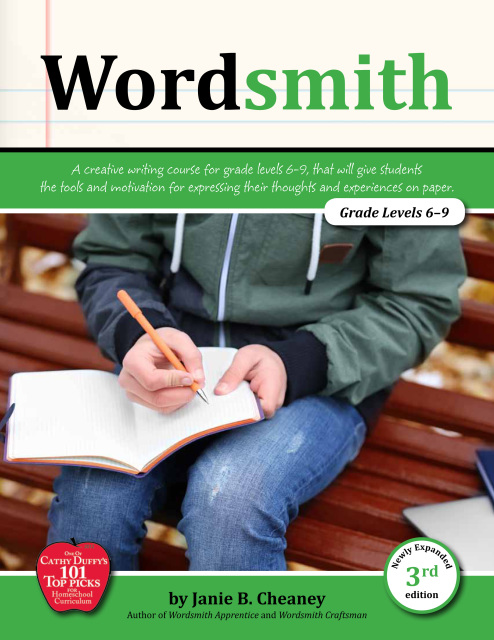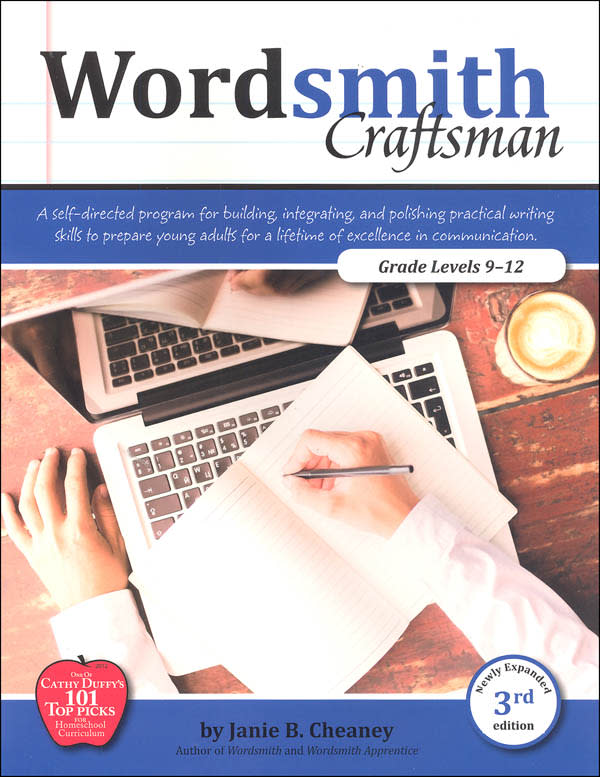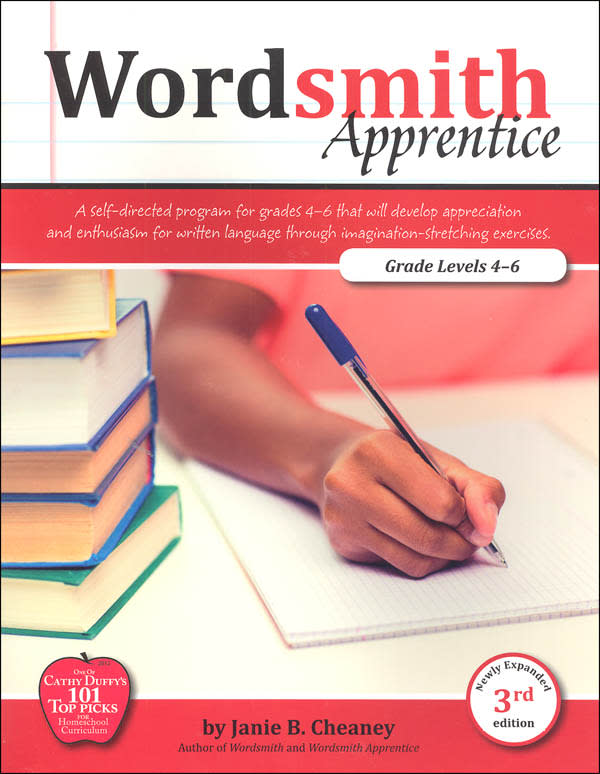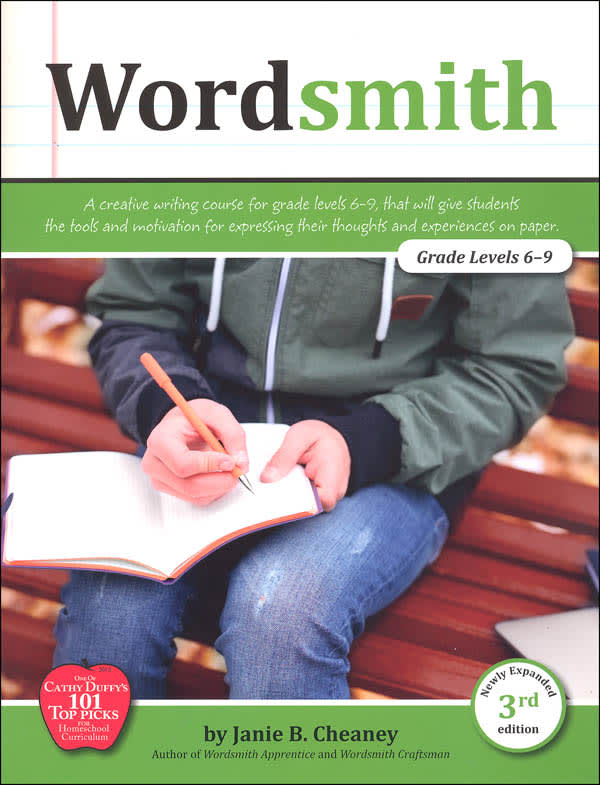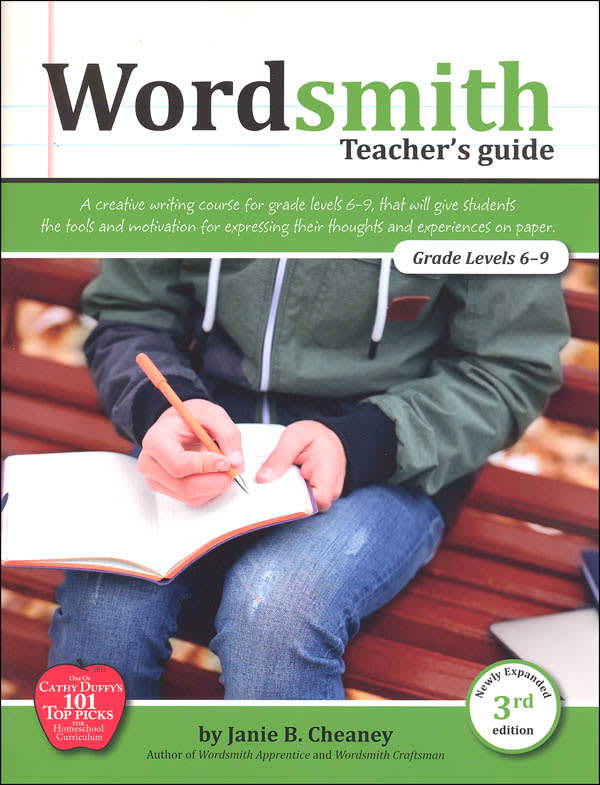Wordsmith is a series of three books for developing writing skills. All books are in their third editions and are available in either print or ebook formats. These are not age-graded, but they address skills at three different levels. My favorite book in the series is Wordsmith: A Creative Writing Course for Young People which targets students around junior high or beginning high school level. My review begins with that book then discusses the other two volumes in relation to it.
Wordsmith
Many students in upper elementary grades and junior high have learned the basics in grammar and need some help transferring grammatical knowledge into their writing. Wordsmith assumes the student knows basic grammar. It moves on from there to work with grammar through written applications. For example, one assignment has them come up with vivid action verbs to replace weak verbs accompanied by adverbs. The goal is to sharpen writing skills by carefully choosing words for the best effect.
After working on grammar, they tackle sentence construction, again with the goal of writing more interesting yet concise sentences. Once grammar and sentence structure are under control, they can apply those skills to compositions.
Although Wordsmith does not teach all the different forms of writing such as reports, research papers, etc., it covers techniques that can be applied in almost any writing situation. Lessons work on skills such as describing people, narrowing the topic, and writing dialogue. At the end of the course, students write their own short story. Helps for proofreading and editing are included along with review quizzes.
The student book may be written in or used as a reusable text by doing the brief activities in a notebook. Lesson organization is clear and well designed. Most students should need a year or more to work through all of the lessons, but with suggestions in the third edition teacher's guide, you might stretch the course to two years. Some teaching, primarily in the form of discussion and evaluation, is required, although students will do much of the work on their own. The author's humorous touches scattered throughout the book add special appeal.
Parents or teachers who lack confidence in their ability to teach students how to write will appreciate the inexpensive teacher’s guide. It includes answers, lesson plans, teaching suggestions, and ideas for expanding lessons. Parents with strong writing skills will probably be able to manage without it.
Other books attempt to meet the same goals, but the presentation here is better than almost everything else at this level.
Note that Wordsmith is now in its third edition. The latest edition is slightly expanded with a bit more content and a few images. One of the most helpful improvements is that it now alerts students to take the quiz at the end of each section, something that was easy to overlook in previous editions.
The new teacher's guide for Wordsmith is expanded as well with more helpful information for parents and teachers. Especially helpful are ideas for additional writing projects and ideas for creative writing in other subject areas. Some students might want to explore other follow-up options in the teacher's guide for organizing a writers' club, entering writing contests, or getting their writing published in some way. (See pages 40 to 45 in the teacher's guide for these additional resources.)
Wordsmith Apprentice
Wordsmith Apprentice is a “prequel” to Wordsmith. Author Janie Cheaney translates the same enthusiasm, humor, and energy that so impressed me in the older-level book to this course for younger students.
Using a newspaper-writing approach, she creates interesting writing activities that develop both grammar and composition skills. For example, in the first section teaching about sentences, students learn the four types of sentences then write four sentences to describe a news photo, mixing declarative, interrogatory, and exclamatory sentences. Stretching beyond the limitations of the newspaper format, students also write invitations, letters, and thank-you notes. “Comic-strips” introduce each new section.
Topics covered are nouns, verbs, sentences, modifiers, prepositions, paragraphs, synopsis writing (often neglected in other courses!), dialogue, opinion writing, and more. These are covered within the context of newspaper tasks such as writing classified ads, travel articles, book reviews, articles, and headlines, as well as editing. Examples and some forms are included, not to stifle or limit students, but to help stimulate their imaginations and give them organizing tools.
Cheaney writes from a Christian perspective, although it comes through subtly. For example, students learn to recognize good synopses by deciding which one of three synopses most accurately conveys the story of David and Goliath. Then an assignment follows to write three synopses, one of which is for the story of The Good Samaritan.
This study is designed for students in grades four through six, and it can be used by students working independently (with parents or teachers reading and responding to exercises and assignments) or by a group of students of mixed ages and abilities.
There is a two-page answer key at the back of the book. There is no teacher manual since none is needed. Free lesson plans are available free on the publisher's website.
Students who have already been introduced to grammar basics will find this a great way to apply what they have learned. Those without prior grammar instruction will need supplemental study defining and identifying grammatical concepts. All students will need a thesaurus and they should also have a newspaper to consult for examples. It need not be current, so you can carefully screen a newspaper for objectionable content.
While Wordsmith Apprentice can be used on its own, Common Sense Press recommends following up with their book Paragraph Writing for Kids (new in 2020).
Wordsmith Craftsman
Designed for high school students, Wordsmith Craftsman can be used after completion of Wordsmith or any other courses that have built up a basic foundation in grammar, mechanics, and composition. High school students who have done a great deal of grammar but little composition should probably complete the Creative Writing Course before jumping into Wordsmith Craftsman.
This book is divided into three parts which can be used over a span of anywhere from one to four years depending upon the student.
Part One draws students into the writing process with practical, everyday writing tasks like note taking, outlining, summarizing, personal letters, business letters, and even business reports (although the last topic is addressed very briefly). Part Two gets more technical with exercises on paragraph writing (narrative, descriptive, persuasive, and expository), word usage, and style. Part Three concentrates on essay writing but builds on paragraph writing skills to create five types of essays: descriptive, narrative, expository, critical, and persuasive.
Cheaney does an excellent job of pointing out different organizational strategies you might use to construct different types of essays. Plentiful examples help students visualize their goals. Cheaney’s emphasis on style encourages students to move beyond mechanical correctness to excellence in communication skills.
Wordsmith Craftsman does not require footnotes and reference citations for the most part, but in the revised third edition sections have been added about plagiarism and when citations are needed to credit source material. Students will complete one assignment that requires them to cite two sources.
The book is written for a student to work through independently, receiving feedback and encouragement from a parent or teacher as needed. There is no teacher manual or answer key since they are unnecessary. Students should work through the lessons at a pace slow enough to allow time for them to practice and master the various skills. A ninth or tenth grader should not expect to complete the book in one year, although an eleventh of twelfth grader might do so.




